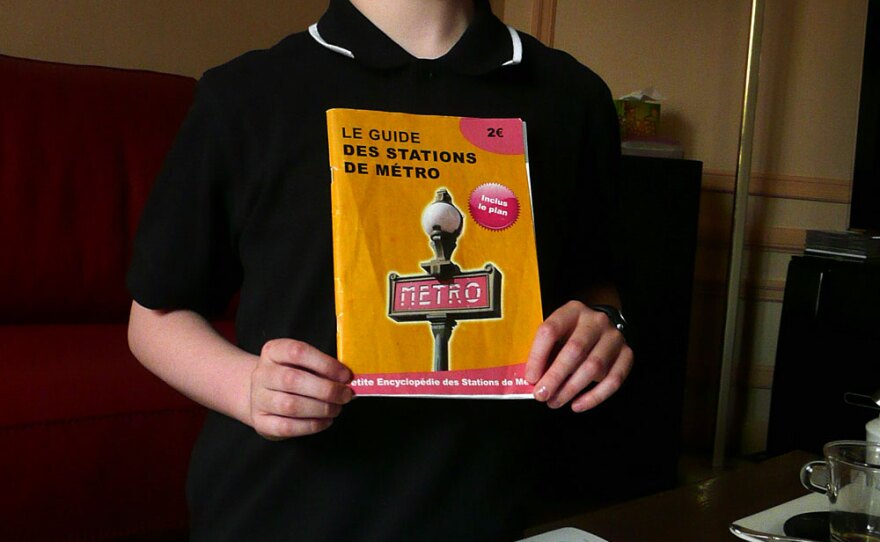Few cities in the world are more identified with their subway systems than Paris. One of the busiest metro systems in the world, it carries more than 4 million riders a day on some 16 lines to 300 stations. To ride it is a visual carnival, a living history, an urban love story about the chemin de fer, or "path of iron."
It's a story that starts at the Chatelet stop in Place St. Opportune, in the heart of Paris. It was one of the very first stops built for the very first line in 1900. It's also the world's largest metro station, with five metro lines and three commuter lines running through it. One of the original archways keeps the art nouveau metropolitan style that's the hallmark of the Paris Metro.
Standing inside the station, author Mark Ovenden says the style was the creation of "an amazingly young architect" named Hector Guimard. "He had the idea of building things out of this wonderfully laced wrought iron that looks like it’s kind of grown there, almost organically -- the way that trees grow or that plants grow. It's a very organic-looking form and quite advanced for its time."
Ovenden is co-author of the book Paris Underground: The Maps, Stations and Design of the Metro. He believes the contrast between the Metro's ornate entrances and the formality of the surrounding boulevard gave the city some sense of nature. That might be one reason that Parisians grew fond of their Metro so quickly, he says. "They were also so totally unique."
In the late 1800s, Paris was well behind London and New York in building a metro system. Visitors to the 1889 Grand Exhibition that featured the Eiffel Tower had to ride a horse and buggy to get there -- an embarrassment that spurred the completion of the Line 1 in time for the World's Fair in 1900. Built in 20 months, this first line of the Metro connected all the major Paris attractions.
Today it's a living, breathing, big-city system -- and rife with fare jumpers. Ovenden sees one and calls out, "Fancy not paying today?" He suspects there are more fare jumpers in Paris than anywhere in the world -- about one in 20, he says.
The Phantom Station
If there is one thing that captures the imagination of Paris Metro aficionados, it's the dozens of abandoned stations -- many closed to be used for bomb shelters during World War II. The trains still hurtle past these empty stations without stopping, like the rail equivalent of the Flying Dutchman.
Julian Pepinster, who co-authored the book Paris Underground with Ovenden, leads tours of the Metro. As a member of the Regione Autonome de Transports Parisian's safety department, he also has the keys to one of these "phantom stations" -- St. Martin, closed for 60 years.
It's well lit, but the sight of an enormous empty Metro station is still eerie. Graffiti taggers have done their worst here, but some unusual advertising art has survived. Pepinster points out amazing bas-relief enamel posters. They're semi-permanent advertisements dating back to a time when products didn't change very often.

One advertisement is both arresting and disquieting. It's for a product called Eau De Javel, bleach. The image shows the silhouette of a black woman through a white sheet she's holding up. "At this time, France still had its colonies in Africa," Pepinster explains. Ovenden translates the advertisement's message: "Here is a black woman, you can see her hand, but she uses bleach and becomes white." It's an ad that wouldn't happen now, they agree.
"What's really weird about walking down here," Ovenden says, is "when you look around you -- apart from the graffiti -- you realize that you’re on a normal Paris Metro station platform. Just the other side of this wall, which has been built since the station was closed, the train’s running. And if you look out the window when you’re on a train that comes from Republique to Strasbourg-Saint-Denis, you can see you're going through an old station."

A Boyhood Love Affair
When Pepinster and Ovenden were little boys, they were perhaps not unlike 11-year-old Adrien Venturi, whose passion has been the Metro since the age of 3. He has the Metro memorized, from its history to its stops. Sitting in his family's flat near the La Motte-Piquet station, he describes the Metro's allure.
"It’s a kind of magic place," he says. "You go in one door, you go out another, you go down on the elevator and then you go up on an escalator."
Adrien says he doesn't know too many others who love the Metro as much as he does. "In school, teachers know how much I love it, so when the teachers are planning a trip, they always ask me, 'What is the best way to go?' 'Where should we get on the Metro?' 'Where should we change?' They know that I’m kind of the expert."
Adrien looks younger than his 11 years and a little like Harry Potter. His eyeglasses enhance his curious, intelligent face. He calculates the route he wants over a placemat depicting the Metro. Soon, he's confidently leading the way to Line 14 -- his favorite.
It's an east-west line that connects France's biggest railroad stations. "It goes very fast, because there’s a very long distance between stations," Adrien says. He loves Line 14 for its speed, but also because it's modern and he likes the double doors that allow passengers to board. It's bright, too. "Not all stations are clean and well-lit," he says.
It's crowded on the Metro, but Adrien isn't bothered. "I find it normal," he says. "It’s what we call transportation, a common transportation. It’s for everybody’s use, so it's normal."
From The Conductor's Seat
But it does get packed, especially in central Paris. At any one time about 600 conductors deliver hundreds of thousands of passengers to 300 Metro stops -- and tunnels are being expanded in the system's periphery to the north and south, from Aubervilliers to Porte d'Orleans.
Elodie Mura is one of the drivers on Line 12. Driving through the tunnels, she points out some of the conductor's controls. "Around the lever here, you have this big ring that you have to activate. You have to do it, like, every 10 seconds or so," she says. "If you don't touch it or activate it, the train automatically stops, because in case the driver has, like, a heart attack or anything that goes wrong for him, so that the train doesn't go on, on its own.
She keeps her eyes out for people who might be tempted to jump in front of her train. "I think about it every day, because it could happen any time, you never know," she says. RATP's safety department says between 100 and 120 people commit suicide this way each year.
"You could have colleagues that can spend their entire life driving and it never happens to them," Mura says, "but others [have had it] happen several times."
But the summertime merriment of life on the Metro does not seem to lend itself to such grim reflection. At any one time, dozens of bands and performers roam the system. The acoustics are particularly good back at Chatelet station, where a Ukrainian band named the Musicians of Lvov play a folksong. It's a song of heartache; the story of a young couple who loved each other very much but had to separate because life was too hard. It has a sweet side, a happy side and a very sad melancholy side. For 1.60 euros per ride, who can beat a show like that?
Copyright 2022 NPR. To see more, visit https://www.npr.org. 9(MDAzMjM2NDYzMDEyMzc1Njk5NjAxNzY3OQ001))






